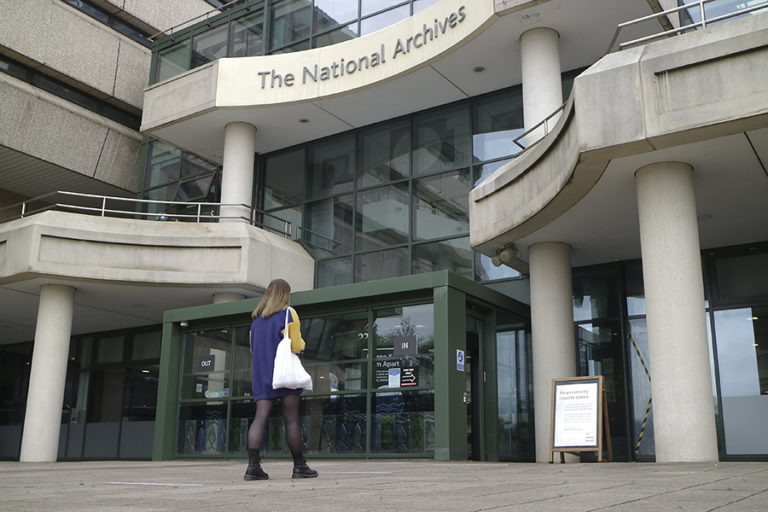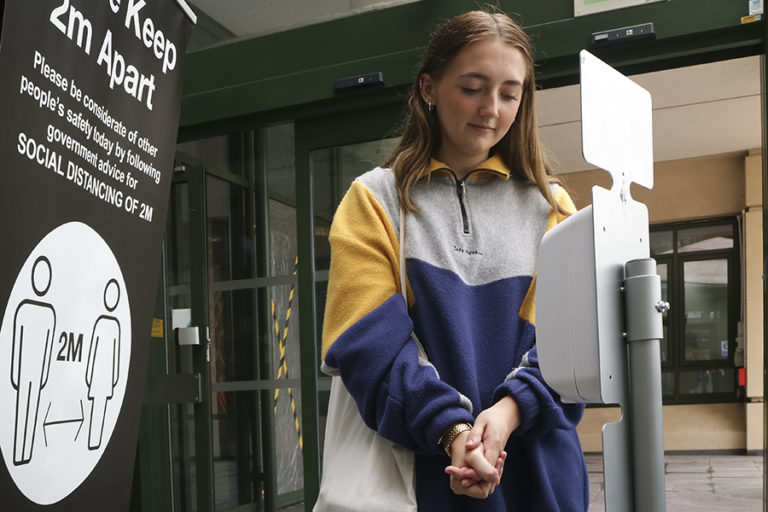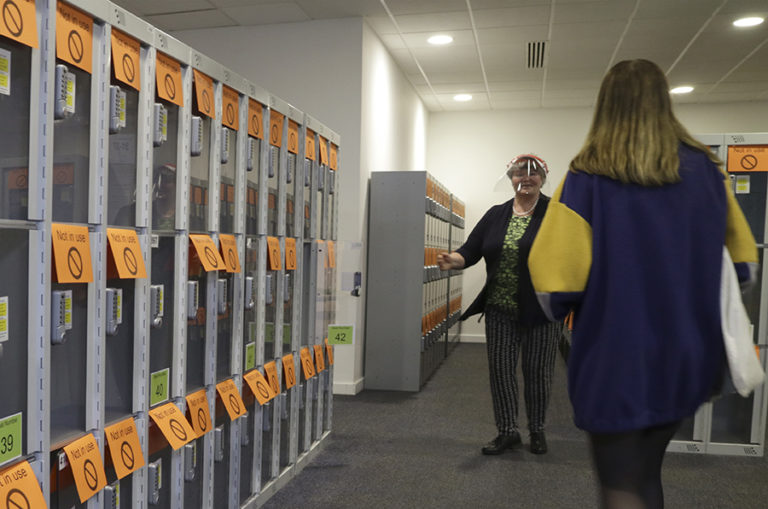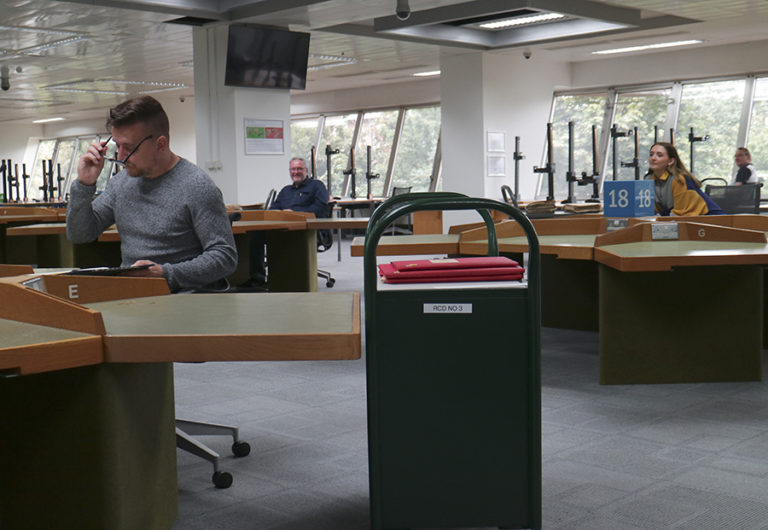In early April, we published a blog about ‘sending the giant to sleep’, which outlined the process we went through to close our building to visitors and staff. As we open our doors today (Tuesday 21 July) to visitors for the first time in four months, we wanted to tell you a bit more about the huge amount of effort and planning that has gone on to get us to this point.
To give you an insight into what we have done to make our building safe for both staff and visitors, we asked two of our Directors who have been most closely involved in this work to explain what has been done.
Paul Davies is our Operations Director – he’s one of the few members of staff that have been working on site throughout the closure period, ensuring the building and its contents are secure, while at the same time overseeing the practical measures we have put in place to make our building COVID-19 acceptable.
Our Director of Public Engagement, Caroline Ottaway-Searle, has been working with her team to provide our visitors with online activities and events which profile our collection, as well as working to put in place procedures which will keep our visitors safe when we re-open.

We were all very sad to close our doors to the public back in March, not knowing when or how we would open them again. Since then, we have been looking forward to the day when it would be possible to welcome readers back to Kew.
Once it became clear that a gradual relaxation of lockdown measures would be introduced, we started to plan our recovery. First we needed to re-mobilise our building, many systems and services having been shut down during lockdown. This involved switching systems back on, flushing water systems and deep cleaning.

So for many weeks now, we have worked through the operational implications of the new world, working with government guidance as it emerges, with the safety of readers and staff our overriding priority.
We have carried out detailed COVID-19-secure health and safety risk assessments, with the support and involvement of staff and trade union colleagues. The results of the risk assessments have been shared with staff and visitors, detailing the measures we have put in place to control the risk. Essential staff have started to return to site to help implement these measures and prepare the building and our services for public opening.

This has been quite a job, re-designing our way of working around social distancing. For us the need to quarantine documents especially has presented challenges, as viewing our documents is the main reason that people come to visit us.
Considerable desk research has been conducted to establish the likely risk of transfer of the virus from various materials, based on scientific research carried out across the world, and guidance from public health bodies. In addition, we have worked with our own conservators and liaised with other archives.
Based on this we have developed a quarantine protocol which is based on a 72-hour interval between each handling of a record. We do understand that this will impact the capacity of the service to the public when they return but our priority is the safety of everyone in our building.

In addition, we have surveyed the building with social distancing measures in mind. Now ‘COVID safe’, there are new layouts, signage, rearranged furniture, screens, hand sanitiser stations, and some staff wearing visors.
As explained above, the service to our readers has been designed around the safe handling of documents that we need to quarantine, as well as maintaining social distancing. This approach will be apparent at all points of our readers’ journey, starting with booking and ordering documents in advance online, and once on site and in the reading room, documents being delivered to readers at their tables.
Things will inevitably look and feel a little different at Kew – there will be fewer people, and ultimately it is people who will breathe life and energy into our giant. We hope that by starting small, we will be able to build and expand our services over time. We will review our processes and what we can offer regularly to reflect government guidelines. In addition, we will look to act on lessons learned about how our visitors are using our reading rooms during this period.
We are very happy to have made a start, and that slowly but surely the giant that we love and have missed is starting to wake up at last.
This short video shows how the building will look different for visitors:
Find out more about what to expect, and how to book your visit.
I am sure I am not alone in being pleased to see (the understandably) still a little sleepy Giant awake and gently stretch.
It clearly has been a huge undertaking for a variety of reasons – not least the fact that most of the activities that visitors engage in a static, taking place at a desk or (obviously in the future) sitting listening to a talk, which is not the norm for museums or galleries etc.
I look forward to seeing the new way of interacting bed in and to the day when I experience it for myself as I’m already compiling a list of documents to peruse.
Remember I get first choice of the Air 14 and Air 81 series!
Well done, though I hope to see access to large documents restored soon as well!
The limits on documents (6) and the failures of the Discovery catalogue (even today) means it is not feasible to spend several hours travelling to look at six documents which would last me just about an hour. I certainly am not going to rush back.
I work at a State Library in Australia and have been watching our Operations Team plan and deploy comparable measures to allow the public to return to our buildings in a staggered approach over the past six weeks. Remote ordering, pre-booking, sanitizing/quarantining borrowed items and distancing measures have all been deployed.
While success can be measured in the fact that no Covid19 outbreaks can be traced to our institution (so far), only time will tell. The vast majority of our non-public facing staff still work from home and many are not comfortable to return to the office yet as it would involve taking public transport. Our management is fully supportive of anyone who wishes to remain working remotely to continue to do so while the pandemic is present.
My own personal opinion is that – as the pandemic situation is so fluid, I wouldn’t be using our reading rooms (or yours) without a mask and gloves. I have elderly relatives and some with suppressed immune systems and it would be extraordinarily irresponsible of me to increase their exposure footprint because I wanted to research the troop movements of the 1st Royal Dragoons.
What is an acceptable risk threshold is going to vary from person to person but everyone has to understand in this pandemic is that we are all interconnected and have social responsibility beyond our immediate circle.
So if I’m saying this from a country with 126 deaths versus your 45,000 (but only 2.5 times our population) you really should be clamping down a lot harder than us.
For those of use who live further afield, like Australia, our time spent being able to research at TNA is now severely limited. I agree with the COVID restrictions and understand why they have been implemented. Of concern to me is that if I order a document on Monday, I can’t get to view it again, if necessary, until Thursday. Now, of course, I could review other documents in those days, but it still extends the time required for research. I can’t just hop on a train and be there in a few hours – it is a marathon effort requiring considerable funds.
Michael makes valid points that no right-minded person could argue with – particularly with the benefit of hindsight – although the response (or ‘knee-jerk’ reaction on many cases) of individual governments is perhaps better left to another forum.
‘Threshold’ fear – that of using public transport and entering premises – is very real everywhere.
Hopefully all such institutions and buildings will have further progressive measures to backup those now in place.
As we know this virus will be with us for the foreseeable and even if/when contained there will be measures that are best left in place, and lessons to be learnt at all levels – not least the huge effect of the ‘digital divide’ concerning the ability to access services online and the many ramifications for that.
As Michael says ‘… we are all interconnected and have social responsibility beyond our immediate circle.’
Openness, transparency and updated information – together with robust alternatives (I too have been affected by the Discovery Download Lottery which has been ongoing for a week) will enable everyone to make the choices that are right for them.
I visited last week. Everything was clear and well organised: the staff, as always, helpful and friendly. The experience however was very surreal. Walking through the document reading room was like going through some recently deserted village!
However not all of the documents I ordered were delivered, which was very frustrating. Thinking about it afterwards. my guess is that they were large items normally produced in the Map and Large Document Reading Room; but you would have to be an expert in the records to know that this was likely to be the case. And I’m certainly not. In addition staff told me that they weren’t producing material from Deepstore – the salt mine in Cheshire where they keep many of the rarely used documents.
Could TNA amend their guidance, perhaps to make it clear that material normally produced in the MLDR or stored in Cheshire will not be available. At present it is rather unclear. Or, better still, provide a helpline where researchers can ring up to check whether items they want to consult will be available. This would save a lot of wasted time for all concerned.
And at six documents a week I want everyone to count!
Thanks
If I recall TNA did say that documents at Deepstore would not be produced and that only the First Floor reading room would be the only one open. The limit of six documents is unreasonable (military researchers have also pointed this out), in local archives you can order up to ten documents and the British Library will be opening their cafe, so why not TNA?. Perhaps TNA can answer why they have chosen 6 documents only, you never know how big or small the contents are, they may only have one sheet of paper. The fact that most of TNA is still closed only reinforces my view is that it is not safe enough to visit.
Please get your record copying service going again ASAP. I don’t see why your staff can’t scan documents and sent out PDFs.